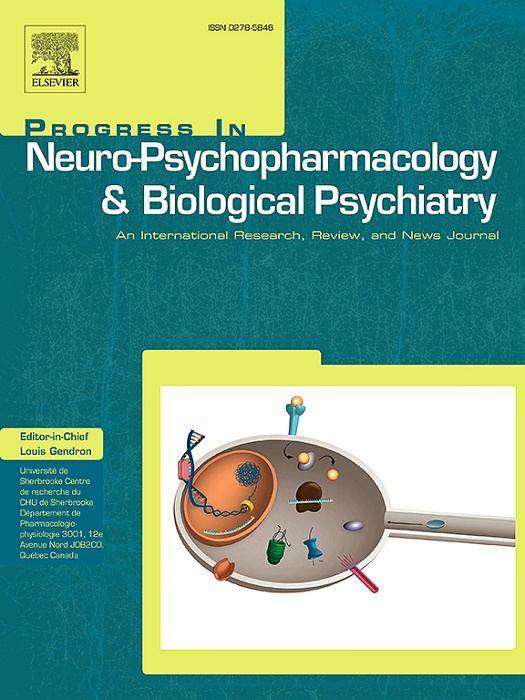早发性精神分裂症青少年丘脑皮质结构连通性失衡。
IF 3.9
2区 医学
Q1 CLINICAL NEUROLOGY
Progress in Neuro-Psychopharmacology & Biological Psychiatry
Pub Date : 2025-06-26
DOI:10.1016/j.pnpbp.2025.111423
引用次数: 0
摘要
背景:以前额叶-丘脑连通性下降和感觉运动-丘脑连通性增加为特征的丘脑皮质电路失衡,已在成人发病的精神分裂症中得到充分证明。我们之前已经证明了早发性精神分裂症(EOS)青少年中该回路的功能失衡。我们现在研究这种功能失衡是否源于EOS的丘脑皮质结构连接,以巩固其与精神病神经发育模型的相关性。方法:研究对象为212名青少年,其中EOS患者145例,健康对照67例。为进一步控制用药效果,将患者分为未用药组和已用药组。以双侧14个感兴趣的皮质区和双侧丘脑分别作为靶区和种子区进行概率神经束造影,以量化丘脑皮质回路的结构连通性。结果:与健康对照组相比,在EOS中,丘脑与背外侧前额叶(dlPFC)和顶叶皮层的结构连通性降低,而与感觉运动皮层的连通性增加。我们还观察到EOS中内侧前额叶皮层(mPFC)与丘脑的连通性意外增加。无论药物状态如何,这种失衡模式在两个亚组中都得到了重复。进一步的相关分析表明,丘脑与dlPFC的低连通性和与mPFC的高连通性都与患者个体症状负担增加有关。结论:青少年精神分裂症患者的丘脑皮质电路功能失衡可能与结构连接失衡有关。一种涉及mPFC的特殊丘脑皮质结构超连通性,以前未在成人发病病例中观察到,可能导致EOS的独特临床表现。本文章由计算机程序翻译,如有差异,请以英文原文为准。
Imbalance of thalamocortical structural connectivity in adolescents with early-onset schizophrenia
Background
Thalamocortical circuit imbalance, characterized by decreased prefrontal-thalamic connectivity and increased sensorimotor-thalamic connectivity, has been well-documented in adult-onset schizophrenia. We have previously demonstrated functional imbalance of this circuit in adolescents with early-onset schizophrenia (EOS). We now investigate whether this functional imbalance stems from the thalamocortical structural connectivity in EOS, thereby further establishing its relevance to the neurodevelopmental modeling of psychosis.
Methods
The study included 212 adolescents (145 EOS patients and 67 healthy controls). To further control the medication effect, the patients were divided into two subgroups (drug-naive vs drug-treated). Fourteen bilateral cortical regions of interest and bilateral thalamus were used as targets and seeds respectively for probabilistic tractography to quantify structural connectivity of the thalamocortical circuit.
Results
Compared to healthy controls, in EOS, structural connectivity of the thalamus with the dorsolateral prefrontal (dlPFC) and parietal cortices was decreased, while connectivity with the sensorimotor cortices was increased. We also observed an unexpected increase in connectivity of the medial prefrontal cortex (mPFC) with thalamus in EOS. The imbalance pattern was replicated in two subgroups regardless of medication status. Further correlation analysis showed that the thalamic hypoconnectivity with the dlPFC and the hyperconnectivity with the mPFC were both related with higher individual symptom burden in patients.
Conclusions
The functional thalamocortical circuit imbalance in adolescents with schizophrenia is underwritten by a similar imbalance in the structural connectivity. A specific thalamocortical structural hyperconnectivity involving the mPFC, previously unobserved in adult-onset patients, may contribute to the distinct clinical manifestations in EOS.
求助全文
通过发布文献求助,成功后即可免费获取论文全文。
去求助
来源期刊
CiteScore
12.00
自引率
1.80%
发文量
153
审稿时长
56 days
期刊介绍:
Progress in Neuro-Psychopharmacology & Biological Psychiatry is an international and multidisciplinary journal which aims to ensure the rapid publication of authoritative reviews and research papers dealing with experimental and clinical aspects of neuro-psychopharmacology and biological psychiatry. Issues of the journal are regularly devoted wholly in or in part to a topical subject.
Progress in Neuro-Psychopharmacology & Biological Psychiatry does not publish work on the actions of biological extracts unless the pharmacological active molecular substrate and/or specific receptor binding properties of the extract compounds are elucidated.

 求助内容:
求助内容: 应助结果提醒方式:
应助结果提醒方式:


